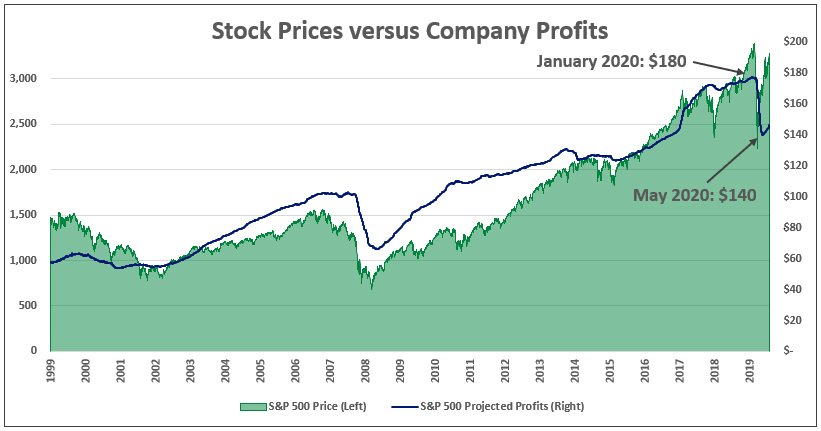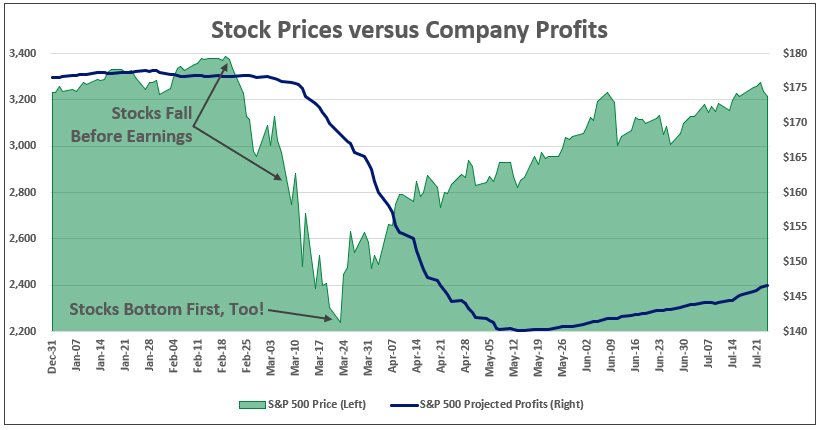Market Prices over time
As investors, we love to study history. We have what we’ll call a “database” of information about every significant market decline in the past 150 years.
We’ve shared in the past that the economy and stock market are related; however, much more loosely than most people think. It turns out that the loose link between the two is typically at its very loosest in recessions. Not only do stock markets start moving higher before recessions end, they usually bottom around the worst part of the recession.
While the best proxy for future stock prices is company profits, many people simply use the economy as the barometer. While they are related, of course, there can be periods when the economy and company profits disconnect, such as the 1970s, when the economy did well, but profits lagged due to increased global competition and inflation, among other things. Weak profits during that decade ultimately led to weak stock returns.
Bringing the conversation between profits and stock prices to recent times, let’s look at what’s happened in 2020. At the start of the year, the S&P 500 was at $3,231, and investors were expecting around $180 per share of earnings (profits). After COVID-19 became a reality and caused widespread shutdowns, those profit estimates dropped to $140 by May (as shown by the dark blue line in the chart below). That $40 decline in profit expectations goes a long way to explain the market’s decline in February and March.
In the chart above, we want you to notice that while stock prices (green) are not as smooth as the profits line (dark blue), they move in roughly the same direction and have a similar shape. Now that you can see the relationship between profits and stock prices, to answer our original question, we need to discuss the timing between the two.
To illustrate this timing, let’s zoom in on the first half of this year.
Stock prices move in anticipation of that blue profit line, not the other way around. In other words, stock markets move because they work to predict the future direction of profits, not to reflect where they’ve been. Here we can see that even though profit expectations didn’t hit their bottom until mid-May, stock prices bottomed two months before that!
This can be a bit of a challenging concept: the stock market predicts more than it reacts. In the short-term, markets try to anticipate the future more than they respond to the past. And that’s why it’s so hard to predict, over a short period, just where the market might go. Case in point: a year ago, who would have predicted an economic shutdown due to a novel virus?
So, what are the big takeaways from all this?
- Company profits act like gravity for stock prices. If investors expect future profits to move up or down, stock prices will too, but not entirely together.
- Markets usually figure out company profit peaks and troughs well before investors do. Often by the time anyone realizes what’s going on, markets have already reacted, and “it’s too late.”
- Often the best time to invest is when things “feel the worst,” and news headlines reflect a dour outlook because if a turn is coming, markets usually start their move well before the headlines improve.
Where does that leave us with answering the question we started with: “How can the market be so strong with such bad economic news?” Our answer is the market is merely saying the worst is probably over, at least in terms of shutdowns and company profits.
Of course, that could change. All kinds of things can impact the next move in profits, and that’s one of the reasons we look to build an “all-weather” portfolio that can be resilient no matter which way the wind blows (or company profits move).
We want to make one last observation. There’s an entire industry that spends a massive amount of effort trying to predict where the stock market will move next. This commentary fills the airwaves and the internet.
But remember, it’s just entertainment. Nobody can predict the future, yet if you log in or turn on the TV, you’ll see predictions everywhere. We’re different. Don’t expect predictions from us; instead, we focus on the following three things to navigate the ups and downs of the market and co-pilot you toward your goals:
- Have a financial plan. Make sure you understand how to get through one of those recessions when it comes (because it will). Try to structure savings & investments with not too much stock that could ruin you, but also not too many “safe” investments that can’t keep up as the cost of living increases (and make you run out of money later in life).
- Be a long-term investor, not a short-term trader. Focus on companies with competitive advantages in attractive industries, with competent partners at the helm, and that add value for all stakeholders: customers, society, employees, and shareholders.
- Be flexible and adapt. No matter how great your plan, life throws curveballs. Flexibility and resilience are essential.
Disclosures
The information provided is for educational and informational purposes only and does not constitute investment advice and it should not be relied on as such. It should not be considered a solicitation to buy or an offer to sell a security. It does not take into account any investor’s particular investment objectives, strategies, tax status, or investment horizon. You should consult your attorney or tax advisor.
The views expressed in this commentary are subject to change based on market and other conditions. These documents may contain certain statements that may be deemed forward‐looking statements. Please note that any such statements are not guarantees of any future performance and actual results or developments may differ materially from those projected. Any projections, market outlooks, or estimates are based upon certain assumptions and should not be construed as indicative of actual events that will occur.
All information has been obtained from sources believed to be reliable, but its accuracy is not guaranteed. There is no representation or warranty as to the current accuracy, reliability or completeness of, nor liability for, decisions based on such information and it should not be relied on as such.
Jacobson & Schmitt Advisors, LLC (“JSA”) is a registered investment advisor. Advisory services are only offered to clients or prospective clients where JSA and its representatives are properly licensed or exempt from licensure.



